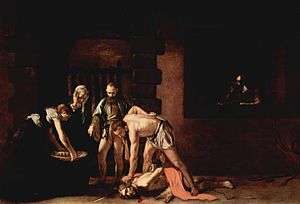The Beheading of Saint John the Baptist (Caravaggio)
 | |
| Artist | Caravaggio |
|---|---|
| Year | 1608 |
| Medium | Oil on canvas |
| Dimensions | 361 cm × 520 cm (142 in × 200 in) |
| Location | St. John's Co-Cathedral, Valletta |
The Beheading of Saint John the Baptist is an oil painting by the Italian artist Caravaggio. According to Andrea Pomella in Caravaggio: An Artist through Images (2005), the work is widely considered to be Caravaggio's masterpiece as well as "one of the most important works in Western painting."[1]
Composition
The image depicts the execution of John the Baptist while nearby Salome stands with a golden platter to receive his head. Another woman, who has been identified as Herodias or simply a bystander who realizes that the execution is wrong,[2][3] stands by in shock while a jailer issues instructions and the executioner draws his dagger to finish the beheading. The scene, popular with Italian artists in general and with Caravaggio himself, is not directly inspired by the Bible, but rather by the tale as related in Golden Legend.[4]
It is the only work by Caravaggio to bear the artist's signature, which he has placed in red blood spilling from the Baptist's cut throat.[5] There is considerable empty space in the image, but because the canvas is quite large the figures are approximately life-sized.[6]
According to John Varriano in Caravaggio: the Art of Realism (2006), Caravaggio drew the background for his picture from the depiction of a prison in the Knights of Malta's penal code.[7] Characteristically of his later paintings, the number of props and the detail in the props used is minimal.[8]
History
Completed in 1608 in Malta, the painting had been commissioned by the Knights of Malta as an altarpiece;[1][9] it was the largest altarpiece which Caravaggio would ever paint.[10] It still hangs in St. John's Co-Cathedral, for which it was commissioned and where Caravaggio himself was inducted and briefly served as a knight.[5][10] Caravaggio's service to the Order was brief and troubled, however, as he was soon a fugitive from justice, having escaped while imprisoned for an unrecorded crime.[3] When Caravaggio was defrocked in absentia as a "putrid and fetid limb" by the Order about six months after his induction, the ceremony took place in the Oratory, before this very painting.[3][11]
Caravaggio did several pieces depicting the moments after the event depicted here. One of these is on display in London's National Gallery; the other, in the Royal Palace of Madrid. It is believed that one of these may be the image that Caravaggio was said to have sent in an effort to appease Alof de Wignacourt, Grand Master of the Knights who expelled Caravaggio, but this is not certainly known.[12]
The Beheading of Saint John the Baptist has been badly damaged,[13] though it did receive some restoration in the 1950s prior to a notable exhibition in Rome in 1955–56, which brought the work considerable attention.[14] It was during the restoration that Caravaggio's signature in the blood became visible to modern viewers.[15] The signature is a matter of some dispute. Some scholars, including Genevieve Warwick in Caravaggio: Realism, Rebellion, Reception (2006), suggest that the work is signed f. Michelang.o (the f to indicate his brotherhood in the order),[16] but it is popularly claimed that Caravaggio signed "I, Caravaggio, did this" in confession of some crime—perhaps connected to the 1606 death of Ranuccio Tomassoni at Caravaggio's hands, which had caused the painter to flee Rome.[17][18][19]
References
- 1 2 Pomella, Andrea (2005). Caravaggio: an artist through images. ATS Italia Editrice. p. 106. ISBN 978-88-88536-62-0. Retrieved 28 June 2010.
- ↑ Harris, Ann Sutherland (2005). Seventeenth-century art & architecture. Laurence King Publishing. p. 48. ISBN 978-1-85669-415-5. Retrieved 28 June 2010.
- 1 2 3 Gaul, Simon (1 October 2007). Malta Gozo & Comino, 4th. New Holland Publishers. p. 109. ISBN 978-1-86011-365-9. Retrieved 28 June 2010.
- ↑ Hibbard, Howard (5 March 1985). Caravaggio. Westview Press. p. 228. ISBN 978-0-06-430128-2. Retrieved 28 June 2010.
- 1 2 Rowland, Ingrid Drake (2005). From heaven to Arcadia: the sacred and the profane in the Renaissance. New York Review of Books. p. 163. ISBN 978-1-59017-123-3. Retrieved 28 June 2010.
- ↑ Hibbard (1985), 232.
- ↑ Varriano, John L. (2006). Caravaggio: the art of realism. Penn State Press. p. 116. ISBN 978-0-271-02717-3. Retrieved 28 June 2010.
- ↑ Varriano (2006), 125.
- ↑ Varriano (2006), pp. 74, 116.
- 1 2 Patrick, James (2007). Renaissance and Reformation. Marshall Cavendish. p. 194. ISBN 978-0-7614-7651-1. Retrieved 28 June 2010.
- ↑ Warwick, Genevieve (2006). Caravaggio: Realism, Rebellion, Reception. University of Delaware Press. p. 30. ISBN 978-0-87413-936-5. Retrieved 28 June 2010.
- ↑ Hibbard (1985), 249.
- ↑ Hagen, Rose-Marie; Rainer Hagen (2 February 2002). What great paintings say. Taschen. p. 216. ISBN 978-3-8228-2100-8. Retrieved 28 June 2010.
- ↑ Hibbard (1985), p. 230.
- ↑ Hammill, Graham L. (15 December 2002). Sexuality and Form: Caravaggio, Marlowe, and Bacon. University of Chicago Press. p. 95. ISBN 978-0-226-31519-5. Retrieved 28 June 2010.
- ↑ Warwick (2006), p. 15.
- ↑ Pencak, William (October 2002). The films of Derek Jarman. McFarland. p. 70. ISBN 978-0-7864-1430-7. Retrieved 28 June 2010.
- ↑ Peachment, Christopher (6 May 2003). Caravaggio. Macmillan. p. 168. ISBN 978-0-312-31448-4. Retrieved 28 June 2010.
- ↑ Jackson, Earl (1995). Strategies of deviance: studies in gay male representation. Indiana University Press. p. 81. ISBN 978-0-253-33115-1. Retrieved 28 June 2010.

